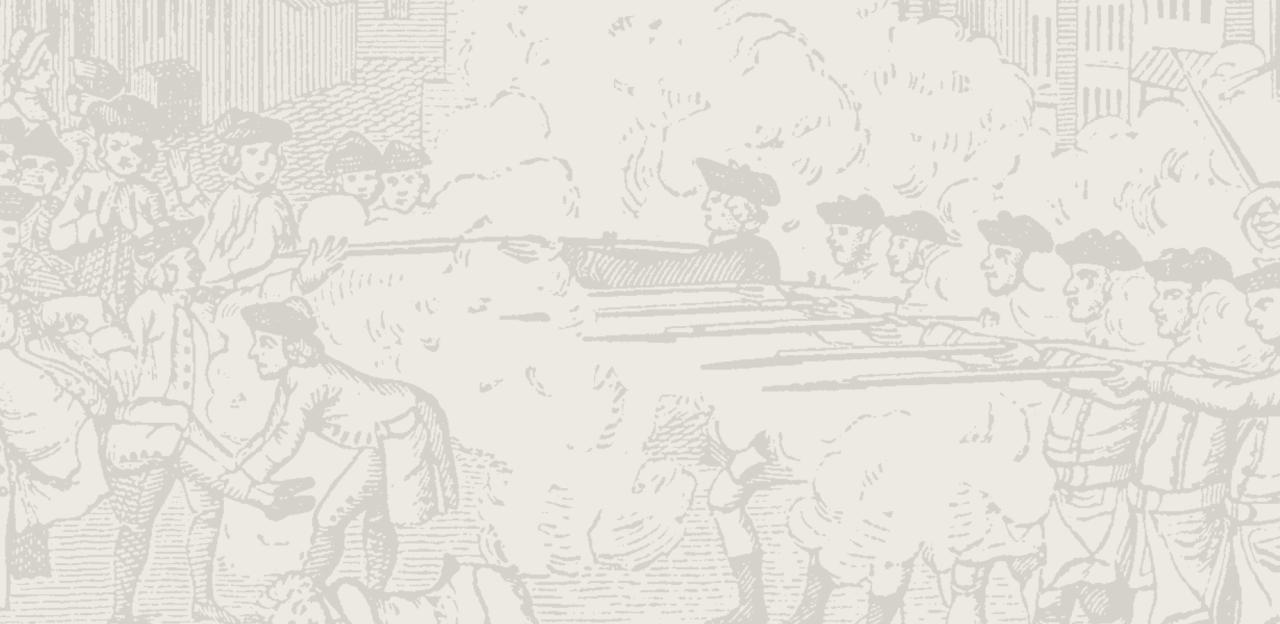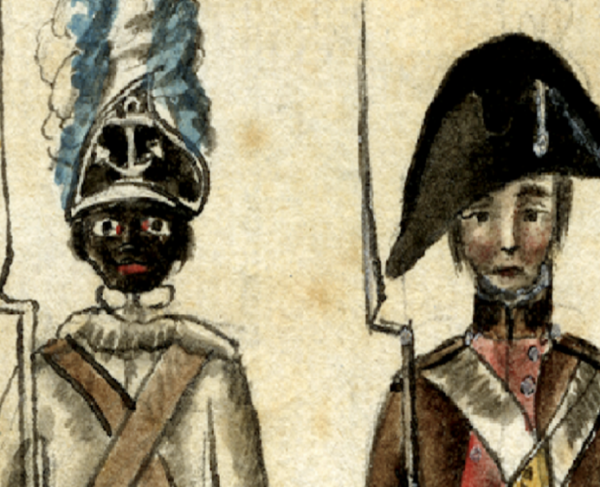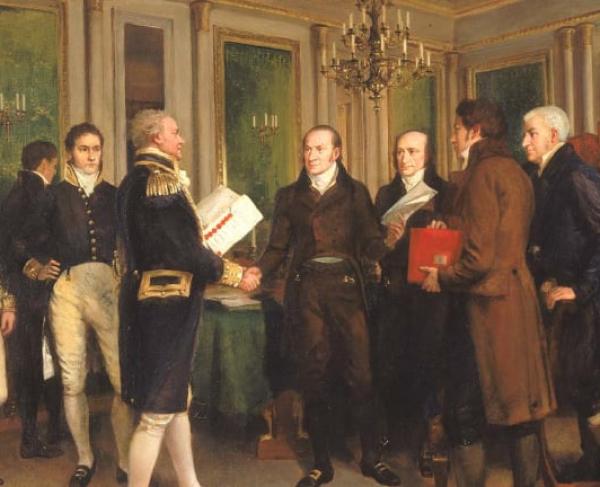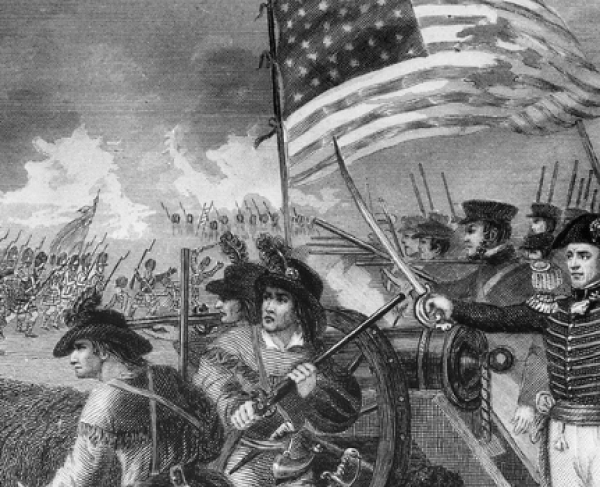A Glossary of Small Arms Across Three Wars

Long Land Pattern “Brown Bess”
Type: flintlock smoothbore musket, muzzle loaded
Ignition system: flintlock
Years of Service: 1722 to 1768
Length: 62.5 inches
Weight: about 10.5 pounds
Ammunition: .69 caliber round ball (.75 caliber bore), paper cartridge
Range: variable, accurate up to 100, effective up to 200 yards
Rate of Fire: three rounds per minute, dependent on the soldier
Muzzle velocity: variable
Short Land Pattern “Brown Bess”
Type: flintlock smoothbore musket, muzzle loaded
Years of Service: 1740 (1768 for infantry) to 1797
Length: 58.5 inches
Weight: about 10.5 pounds
Ammunition: .69 caliber round ball (.75 caliber bore), paper cartridge
Range: variable, accurate up to 100, effective up to 200 yards
Rate of Fire: three rounds per minute, dependent on the soldier
Muzzle velocity: variable
Third, or India, Pattern “Brown Bess”
Type: flintlock smoothbore musket, muzzle loaded
Ignition system: flintlock
Years of Service: 1797 to 1854
Length: 55.25 inches
Weight: 9.68 pounds
Ammunition: .69 caliber round ball (.75 caliber bore), paper cartridge
Range: variable, accurate up to 100, effective up to 200 yards
Rate of Fire: three rounds per minute, dependent on the soldier
Muzzle velocity: variable
The workhorse of the American Revolution, seen on every battlefield of the war, was the British Short Land Pattern musket, commonly called the “Brown Bess.” A marvel of simplicity and durability, Land Pattern muskets saw action on four continents during a century of service spanning 1722 to 1854.
The first, or Long, Land Pattern musket was Britain’s first standardized infantry weapon, with a .75 caliber bore, firing a .69 caliber round ball. The difference between the bore size and projectile size, called “windage,” aided with reloading speed but made the weapon inaccurate. Adding a seventeen-inch bayonet effectively made the musket a six and a half foot spear, illustrating the link between the old seventeenth century pike and matchlock New Model Army of Oliver Cromwell.
At this point in history, speed was more important than accuracy. A British Regular was expected to fire three rounds per minute. The effective range of the Land Patterns was up to 300 yards, accuracy was limited to about 100 yards, but most commanders favored volley fire at 50 yards, or even closer.
In 1768, the British switched to the Short Land Pattern, sawing four inches off the total length, but still maintaining the same caliber, ammunition, and weight. British Dragoons had used the Short Land since 1740, with the slightly shorter length aiding in loading. Most British Redcoats carried Short Land Patterns, with a few Long Patterns mixed in, during the Revolution. In addition, many Short Land Patterns found their way into Patriot hands throughout the conflict.
When the War of 1812 erupted, the British army had converted to the shorter and lighter Third Pattern musket. Other than the length and weight, Third Pattern muskets were identical to their predecessors. It was the Third Pattern that defeated Napoleon, twice, in Europe, and would be carried yet again in North America.
French Infantry Musket “Charleville” Model 1763/1766/1777
Type: flintlock smoothbore musket, muzzle loaded
Years of Service: 1763 to 1839
Length: 60 inches
Weight: about 10 pounds
Ammunition: .66 caliber round ball (.69 caliber bore), paper cartridge
Range: variable, accurate up to 100, effective up to 200 yards
Rate of Fire: three rounds per minute, dependent on the soldier
Muzzle velocity: variable
In 1717, the French army moved to standardize its main infantry weapon and adopted the French Infantry musket, common called the Charleville musket after the main French armory. The Charleville was slightly smaller and lighter than its British counterpart, and its projectile fitted slightly tighter, giving it a slight edge in accuracy. A fifteen inch bayonet completed the weapon.
In 1763, with experiences learned during the French and Indian (Seven Years) War, the French introduced the Model 1763 Charleville. This model was shorter, cut down to 60 inches, but heavier at over ten pounds. In 1766, the French made slight modifications, lightening the Model 1763 back to about ten pounds. The Model 1763 and Model 1766 were supplied in large numbers to Patriot forces during the American Revolution. When the United States created its own standard infantry weapon, the Springfield Model 1795, it borrowed heavily from the Model 1766.
In the 1770s, the Charleville underwent a series of modifications, including a different ramrod housing, altered stock, improved hammers, and altered trigger guards. The result was the Model 1777. The Model 1777 was the primary weapon used by French troops fighting in North America, and abroad, during the American Revolution. Charleville muskets would see service well into the Nineteenth Century, and would arm the armies of Napoleon throughout the Napoleonic Wars, pitting Brown Bess against Charleville yet again.
American Long Rifle, “Pennsylvania” Rifle, “Kentucky” Rifle
Type: flintlock rifle, muzzle loaded
Years of Service: about 1700 to 1900
Length: 54 to 70 inches
Weight: 7 to 10 pounds
Ammunition: commonly .40 to .48 caliber round ball, paper cartridge or loose powder
Range: variable, accurate up to 200, effective up to 400 yards
Rate of Fire: Two rounds per minute, dependent on the soldier
Muzzle velocity: variable
The Long Rifle traces its origins to the early 1700s and the American Frontier, specifically southeastern Pennsylvania, earning it the name Pennsylvania Rifle. The American Long Rifle represented the needs of the frontier. Able to be made by hand, without complex tools, and based off a rough pattern, the Long Rifle traded accuracy for reloading speed, a necessity for hunters on the frontier.
A Long Rifle stretched its effective range to 200 yards. Many Long Rifles used smaller balls, ranging in size from about .30 to .50 calibers. With a smaller projectile, fitting tighter to the barrel, and a longer barrel to give the black powder time to expand, most Long Rifles had a much higher muzzle velocity than their smoothbore counterparts, resulting in a much higher lethality at longer range.
With the outbreak of the American Revolution, rifles found their way on to early battlefields in the hands of the militia. The slower rate of fire, and lack of a bayonet, made the rifle ill-suited for traditional linear warfare. Where the rifle excelled, however, was in the skirmish line and in ambush tactics perfected by the Patriots. As the war evolved, American commanders began to identify the battlefield usefulness of the rifle, and battles such as Saratoga and Cowpens saw effective use of the technology.
Ferguson Rifle
Type: flintlock rifle, breech loaded
Years of Service: 1776-1778
Length: 48-60 inches
Weight: about 7.5 pounds
Ammunition: .615 caliber round ball (.65 caliber bore), paper cartridge
Range: variable, accurate up to 300
Rate of Fire: seven rounds per minute, dependent on the soldier
Muzzle velocity: variable
In 1770, an enterprising young Major, Patrick Ferguson, designed a rifle of his own. Ferguson, an officer in a British Light Infantry Company, saw the evolution of skirmish and light infantry tactics, and wanted to design a weapon to match. The rifle featured a screw in the breech that, when lowered, allowed the weapon to be loaded from the rear rather than the muzzle. This greatly improved the rate of fire, and helped alleviate the slow rate of fire seen in other rifles. In a single bound, the Ferguson Rifle would set the model for many breech-loading military rifles a century later.
Only about 200 Ferguson Rifles were produced. Ferguson and his Experimental Rifle Corps fought during the Battle of Brandywine with mixed success, and Ferguson’s wounding. The British army rejected the Ferguson Rifle for standard issue because of its expense and complexity in manufacturing, and inability to withstand the rigors of combat. Despite rejecting the Ferguson, the British Army was beginning to recognize the usefulness of rifles on the battlefield, directly leading to the first standard issued British rifle: the Baker Rifle.
Springfield Model 1795
Type: flintlock smoothbore musket, muzzle loaded
Years of Service: 1795-1865
Length: 60 inches
Weight: 10 pounds
Ammunition: .66 caliber round ball (.69 caliber bore), paper cartridge
Range: variable, accurate up to 100, effective up to 200 yards
Rate of Fire: three rounds per minute, dependent on the soldier
Muzzle velocity: variable
The Springfield Model 1795 was the first standard issue musket produced by the young United States. Borrowing heavily from the Charleville, the Model 1795 saw extensive service during the War of 1812. Like the Charleville, the Model 1795 fired a slightly smaller ball than the India Pattern “Brown Bess,” giving it a slight edge in range and accuracy than its British opponent.
Like many muskets of the era, the Model 1795 had replacement part issues. Most musket parts were machine made to a rough pattern, but then hand finished to fit each weapon. This meant that parts were often not interchangeable, or only interchangeable with great difficulty, between weapons. To alleviate this, the Springfield Armory created the Model 1812 and Model 1816 based on the Model 1795 design, but the newer models did not see action during the War of 1812.
Model 1795 muskets also saw action during the Mexican War, and the early days of the Civil War. Most Union issued Model 1795s were converted to percussion cap, but some Confederate soldiers were still carrying flintlocks during the early stages of the war. Design elements from the Model 1795 can be seen in subsequent patterns up to the Model 1863. Because of its history, the Model 1795 has become iconic, crossed Model 1795s are the symbol of the infantry branch of the modern U.S. Army, and adorns the Combat Infantryman Badge.
Harpers Ferry Model 1803
Type: flintlock rifle, muzzle loaded
Years of Service: 1803-1865
Length: 49-52 inches
Weight: 9 pounds
Ammunition: .525 caliber round ball (.54 caliber bore), paper cartridge
Range: variable, accurate up to 200 yards, effective up to 300 yards
Rate of Fire: one round per minute, dependent on the soldier
Muzzle velocity: variable
The Harpers Ferry Model 1803 was the United States military’s first standard issue rifle. In 1803, Secretary of War Henry Dearborn requested a “short-barreled rifle,” which he thought would be better suited to the battlefield and help alleviate the fouling issues of rifles of the time. While the shorter barrel reduced long-range accuracy, the weapon was formidable, and short barrel rifles would see combat through the Civil War. The Model 1803 also featured a “patch box” cut into the butt of the rifle, for storage of the precut patches used to help the ball grip the rifling more tightly.
To accompany the newly produced Model 1803, the U.S. military created the Regiment of Rifles. This unit saw action at the Battles of York and Big Sandy Creek, seeing widespread usage in the Western Theater of the War of 1812. Like many weapons produced during the early nineteenth century, the Model 1803 also saw combat during the Mexican War, and a few were pressed into service during the Civil War.
Springfield Model 1861/1863
Type: percussion cap rifled musket, muzzle loaded
Years of Service: 1861-1873
Length: 56 inches
Weight: 9 pounds
Ammunition: .58 caliber Minié ball, paper cartridge
Range: accurate up to 500 yards, effective up to 1,000 yards
Rate of Fire: three rounds per minute, dependent on the soldier
Muzzle velocity: 950 feet per second
No Civil War weapon is more iconic than the Springfield Model 1861. While not the first of the rifle-muskets, nor the first to use the percussion cap or the Minié ball, more Model 1861s saw service during the war than any other small arm. An improvement on the Model 1855, which was the first standard issue rifled musket used by the United States, the Model 1861 represented the apex of infantry technology at the outbreak of the war.
The invention of the Minié ball in the middle of the Nineteenth Century revolutionized infantry weapons and ushered in the age of the rifle. The conical design of the Minié ball meant that it flew more accurately than a round ball. With Captain James Burton’s Harpers Ferry design, a cavity at the base of the bullet, a tighter seal between projectile and rifling was made, increasing muzzle velocity, range, and accuracy.
Compared to smoothbore predecessors, the Model 1861 had far longer range, and much better accuracy. The percussion cap system also alleviated the problems of priming a flintlock pan with an unknown measure of powder, helping to standardize each charge fired.
By 1862, most Union soldiers were equipped with rifled muskets, and many carried the Model 1861. This meant that the average infantryman was far more lethal than in previous wars, with a highly accurate long-range weapon. Tactics and training lagged behind, however, and most infantrymen on both sides struggled to hit targets at range or utilize the weapon’s sights effectively. Because of this, most Civil War battles closely resembled their Revolutionary War and War of 1812 counterparts: close range exchanges of lethal volleys.
During the course of the war, the Model 1861 was modified slightly, producing the Model 1863. Many of the Model 1863s were converted to “Trapdoor” breechloaders after the war, making it the last muzzle loading rifled musket produced by the United States. Almost two million Model 1861 and 1863s were produced during the Civil War, making it the most widely used small arm of the war.
Enfield Pattern 1853
Type: percussion cap rifled musket, muzzle loaded
Years of Service: 1853-1889
Length: 55 inches
Weight: 9.5 pounds
Ammunition: .58 caliber Minié ball, paper cartridge
Range: accurate up to 500 yards, effective up to 1,000 yards
Rate of Fire: three rounds per minute, dependent on the soldier
Muzzle velocity: 900 feet per second
Much like their American counterparts, the British moved towards percussion cap rifles around mid-century. While the Pattern 1851 Enfield was the first of this line, the Pattern 1853 had the largest impact on the Civil War. The Enfield Pattern 1853 also had the distinction of seeing action during the Crimean War, where its qualities were well documented.
The British were happy to trade with both sides during the Civil War, making Pattern 1853 the second most widely used small arm of the war. The similarities in caliber meant that Enfield and Springfield ammunition was interchangeable, a major advantage for both armies who were struggling with the plethora of weapons in use. From spring 1862 onwards, Enfield Pattern 1853s began to make their appearance on Civil War battlefields.
For the Confederacy, the Enfield Pattern 1853 represented the most readily available small arm, and was highly sought after. Because of Confederate manufacturing limitations, the Enfield made up the majority of their rifles carried by the infantry by war’s end. While almost identical in terms of range and accuracy as the Springfield Model 1861, most of the Enfields purchased by the Confederacy were made by contractors, and suffered from inferior parts and difficulties with interchangeability. Given the choice, many Confederate soldiers preferred the Springfield, but picked the Enfield over all other options.
Sharps rifle
Type: percussion cap rifle, breech loaded
Years of Service: 1850-1881
Length: 47 inches (carbine 39 inches)
Weight: 9.5 pounds (carbine 8 pounds)
Ammunition: .52 caliber Minié ball, paper cartridge
Range: accurate up to 500 yards, effective up to 1,000 yards
Rate of Fire: eight to ten rounds per minute
Muzzle velocity: 1,200 feet per second
Designed in 1848, the Sharps rifle represented the leading edge in advanced small arm technology. The Sharps utilized a “falling block,” which opened the breech when the trigger guard was lowered. To load the weapon a cartilage was placed in the breech, the block was closed shearing the cartilage and exposing the powder, the hammer was cocked, and a percussion cap was placed. Despite this loading process, the Sharps had tripled the rate of fire when compared to the Springfield.
The United States government was hesitant to move towards breech loading weapons, fearing that infantrymen would expend their ammunition too quickly and that the supply could not keep up with vastly increased rates of fire. Because of this, the Sharps and other breechloaders were slow to see service during the Civil War. In addition, the added complexity in the mechanism made the Sharps more expensive than a muzzleloader.
It would be the cavalry, who favored easier loading on horseback that a breechloader provided, who employed the largest numbers of Sharps during the Civil War. To further aide with mobility, a shorter, lighter, carbine version was used by the cavalry. While primarily a Union weapon, some Sharps did find their way into Confederate hands, and the similarity of Sharps’ carriages with other weapons meant that the Confederacy could supply the ammunition.
Another place the Sharps found extensive action was with the United States Sharpshooters, commonly called “Berdan’s Sharpshooters.” These green clad sharpshooters used the Sharps rate of fire and their training to lethal effect. With range and accuracy identical to, or better, than a Springfield Model 1861 rifled musket, the Sharps were a readymade marksman’s weapon. In addition, it could be loaded and fired kneeling or prone much easier than a muzzleloader, a must for skirmishers.
Spencer rifle
Type: repeating rifle, magazine loaded
Years of Service: 1860-1920
Length: 47 inches (carbine 39 inches)
Weight: 9.5 pounds (carbine 8 pounds)
Ammunition: .52 caliber, rimfire brass cartridge
Range: accurate up to 200 yards, effective up to 500 yards
Rate of Fire: fourteen to twenty rounds per minute
Muzzle velocity: 1,200 feet per second
In 1860, the most innovative small arm widely available was the Spencer rifle. The Spencer was truly ahead of its time, it holds the distinction of being the first military repeating rifle in the world. Building off existing breech loading technology, the Spencer added two key design features: a magazine and metallic cartridges. A lever action chambered a round and the hammer was cocked manually before firing. This action combined with the seven round magazine, made the Spencer a true rapid fire weapon.
The invention of the metallic cartridge sought to solve the problem of paper cartridges being vulnerable to bad weather and dampness. In addition, by integrating the firing cap and the cartridge together a step of the loading process was removed. To facilitate loading, the Spencer also introduced a seven round magazine located in the butt of the rifle. Soldiers carried multiple preloaded tubes in a large Blakeslee Cartridge Box to speed up the loading process.
Initially, the Spencer met with the same criticism as other repeating and breech loading weapons; that soldiers would fire too quickly and waste ammunition, and that the supply train could not keep up with demand. Because of this, Spencers did not see action until mid-1863 at Gettysburg.
Cavalry favored the Spencer because of the difficulties loading a weapon on horseback. At first Union cavalry was issued the normal, longer, rifle version, but carbines did see service towards the end of the war. For the Confederacy, the Spencer rifle proved impossible to supply when southern manufacturing could not produce the complex rimfire cartridge.
The Spencer rifle represented the future of combat small arms, but tactics lagged behind technology. While the rifle was capable of large volumes of fire, linear tactics prevented commanders from fully exploiting this capability. It would take another century before infantry tactics could evolve to match; even the First World War is proof that technology had still overreached tactics.
Glossary
Lock, stock, and barrel: The three key parts that make up an Eighteenth and Nineteenth Century weapon. The lock is the mechanical parts of the firearm, the springs that hold the hammer in place and cause it to discharge when the trigger is pulled. In addition, the lock contains the ignition mechanism that discharges the powder held in the barrel. The stock is the wooden elements of the weapon that house the lock and keep the barrel in place. Finally, the barrel is the tube that contains powder and projectile, and directs it down range when ignited.
Effective range: The longest range a projectile could travel and still cause harm. Often this range was not practical for military purposes because the weapon had to be angled excessively to achieve the distance.
Accurate range: The range a weapon could accurately hit a man-sized target repeatedly. While many weapons could throw a projectile further, outside accurate range hitting a target becomes a matter of luck.
“Round:” The projectile for a firearm. The name derives from the early round ball projectiles used until the invention of conical projectiles.
“Windage:” The difference, or space, between the size of a projectile and the barrel bore. A tighter fitting projectile meant better accuracy and a higher muzzle velocity, but slowed loading in muzzle loading weapons. As technology progressed a tighter fit between projectile and barrel were achieved.
Rifled musket: A weapon that maintains the same length and weight as smoothbore muskets, but is rifled. Many nations mandated that infantry weapons maintain a specific length (50-60 inches) so that rank fire and linear tactics could be maintained. Shorter weapons meant that the second rank’s barrels would not clear the front of the first rank, making for an unpleasant situation when the weapon goes off. The longer length was also maintained so that bayonets had a longer reach in hand-to-hand combat, and to defend against cavalry.
Carbine: A shorter version of a rifle or rifled musket, often used by cavalry, artillery, and specialists.
Rifle: A weapon with a rifled barrel for increased accuracy. The primary difference between a rifle and rifled musket is the size of the weapon, rifles tended to be slightly shorter and not meant to be fired in ranks.
Small arms: Defined as man-portable firearms. This includes shoulder weapons like muskets and rifles, sometimes called “long guns,” and handguns like pistols.
Flintlock: an ignition system prevalent in the Eighteenth and early Nineteenth century. A sharpened flint held by the hammer strikes a steel dropping sparks into a pan of loose powder. The ignition of the pan spread through the touchhole into the barrel to set off the main charge. The measure of powder to prime the pan resulted in variable amounts being poured in the barrel, resulting in inconsistency in range. A “flash in the pan” is when the pan ignites but not the main charge, and is where the idiom comes from.
Percussion lock: an improvement on the flintlock, replacing flint and loose powder with a percussion cap of fulminated mercury. The impact of the hammer on the cap caused a spark, which would set off the main charge. The percussion cap was less vulnerable to dampness or wetness, and ensured a consistent charge was poured in the barrel.
Maynard tape primer: designed to simplify the loading procedure of percussion cap rifled muskets, instead of a single cap the Maynard tape contained a series of caps. The soldier would advance each cap before firing rather than having to reach into a cap pouch. While practical during testing, the system was unreliable in the field. The Springfield Model 1855 was designed for this system, but single percussion caps could still be used. The Maynard tape primer is the predecessor to modern cap guns.
Rimfire: an early metallic cartridge ignition system, where the crimped edge of a cartridge contains fulminated mercury that ignited when struck by the hammer. While a major advancement in technology, locating the ignition source on one edge of the cartridge made for an uneven burn of the powder. A similar ignition system is the pinfire, which required the hammer to strike a pin to ignite the charge. Modern centerfire metallic cartridges trace their origins to both systems.


